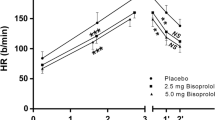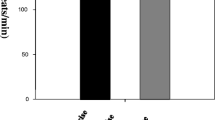Summary
The effect of β-adrenergic receptor blockade on exercise-induced lipid peroxidation in man has been examined by measuring the production of pentane in expired air. For this purpose, five healthy male subjects were subjected to dynamic exercise of graded intensity on a cycle ergometer (10 min at 45%, 5 min at 60% and 75% maximal oxygen uptake 1 h after ingestion of either a placebo or 40-mg propranolol. At rest, mean pentane concentration ([pent]) with placebo was 4.13 pmol · l−1, SD 2.14. After exercise, this value significantly increased by 310% (17.1 pmol · l−1, SD 7.73, P < 0.01). Oral administration of 40-mg propranolol significantly lowered the mean resting [pent] to 1.75 pmol · l−1, SD 0.77, P < 0.05. After exercise, the increase of [pent] was much smaller (240%) and was less significant (P < 0.2) than with the placebo. The mechanism of this inhibitory effect of propranolol remains to be elucidated. However, as indicated by the measurement of plasma myeloperoxidase concentration, it can be concluded that the antioxidant property of propranolol cannot be attributed to the inhibition of neutrophil activation, a possible source of free radicals during exercise.
Similar content being viewed by others
References
Ahlborg B, Ahlborg G (1970) Exercise leucocytosis with and without betadrenergic blockade. Acta Med Scand 187:241–246
Alessio HM, Goldfarb AM (1988) Lipid peroxidation and scavenger enzymes during exercise: adaptive response to training. J Appl Physiol 64:1333–1336
Borg DC (1976) Applications of electron spin resonance in biology. In: Pryor WA (ed) Free radicals in biology, vol. 1. Academic Press, New York, pp 69–145
Chance B, Sies H, Bovers A (1979) Hydroferoxide metabolism in mamalian organs. Physiol Rev 59:527–605
Clark RA (1983) Extracellular effects of the myeloperoxidase-hydrogen peroxydexhalide system. In: Weissmann G (ed) Advances in inflammation research, vol. 5. Raven Press, New York, pp 107–146
Damas P, Lamy M, Deby-Dupont G, Pincemail J, Gysen P, Deby C (1988) Granulocytes myeloperoxidase release during septic shock in humans. Second Vienna Shock Forum, May 11–14, 1988, Vienna, Austria, Abstracts available from Liss A (ed) p 11
Davies KJA, Quintanilha AT, Brooks GA, Packer L (1982) Free radicals and tissue damage produced by exercise. Biochem Biophys Res Common 107:1198–1205
Deby-Dupont G, Pincemail J, Thirion A, Deby C (1987) A radioimmunoassay for polymorphonuclear leucocytes myeloperoxidase. Arch Int Physiol Biochim 95:S9-S11
Dillard CJ, Litov RE, Savin WM, Dumelin EE, Tappel AL (1978) Effects of exercise, vitamin E, and ozone on pulmonary function and lipid peroxidation. J Appl Physiol 45:927–932
Forster NK, Marlyn JB, Rangno RE, Hogg JC, Pardy RL (1986) Leukocytosis of exercise: role of cardiac output and catecholamines. J Appl Physiol 61:2218–2223
Gee DL, Tappel AL (1981) Effect of exercise on expired pentane as a measure of in vivo lipid peroxidation in the rat. Life Sci 28:2425–2429
Hochstein P, Jain SK (1981) Association of lipid peroxidation and polymerization of membrane proteins with erythrocyte aging. Fed Proc 40:183–188
Mak IT, Weglicki WV (1988) Protection by β-blocking agents against free radical-mediated sarcolemmal lipid peroxidation. Circ Res 63:262–266
Lew H, Pyke S, Quintanilha A (1987) The effects of physical exercise on the antioxidative capacity of the liver. Bioelectrochem Bioenerg 18:231–246
Packer L 1988 Biochemical aspects of physical exercise. Benzi G ed Elsevier, North Holland, New York, 73–92
Pincemail J, Deby C, Dethier A, Bertrand Y, Lismonde M, Lamy M (1987) Pentane measurement in man as an index of lipoperoxidation. Bioelectrochem Bioenerg 18:117–126
Pincemail J, Faymonville ML, Lamy M (1989a) Role of neutrophils in critically ill patients: myeloperoxidase, a specific marker of their activation. In: Vincent JL (ed) Update in intensive care and emergency medicine, vol. 8. Springer, Berlin Heidelberg New York, pp 24–32
Pincemail J, Faymonville ML, Deby-Dupont G, Thirion A, Deby C, Lamy M (1989b) Neutrophils activation evidenced by plasmatic myeloperoxidase release during cardiopulmonary bypass in man. Consequences on vitamin E status. In: Diplock AT, Macklin LJ, Pryor WA (eds) Vitamin E biochemistry and health implications, vol 570, Annals of the New York Academy of Sciences, pp 501–502
Pitkänen OM, Hallman M, Andersson SM (1989) Determination of ethane and pentane in free oxygen radical-induced lipid peroxidation. Lipids 24:157–159
Schaefer RM, Kokot K, Heidland A, Plass R (1987) Jogger's leukocytes. N Engl J Med 316:223–224
Author information
Authors and Affiliations
Rights and permissions
About this article
Cite this article
Pincemail, J., Camus, G., Roesgen, A. et al. Exercise induces pentane production and neutrophil activation in humans. Effect of propranolol. Eur J Appl Physiol 61, 319–322 (1990). https://doi.org/10.1007/BF00357620
Accepted:
Issue Date:
DOI: https://doi.org/10.1007/BF00357620




